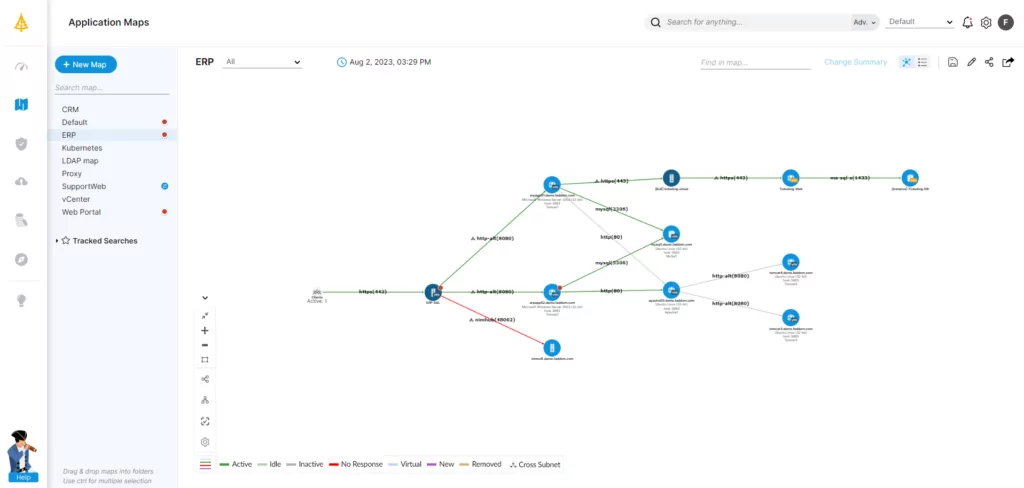There’s a growing trend of organizations leaving the cloud and moving to on-premises infrastructure. There are several reasons why the cloud didn’t work for these organizations and they were unable to reap the benefits. High cost was a common factor along with the lack of customization. Some bore the brunt of significant financial hits due to operational inefficiencies in a nonoptimal infrastructure. Security and compliance issues were also significant reasons for companies choosing to head to older pastures.
In a 2021 study, 415 Research found that 48% of the organizations surveyed had migrated out of the cloud and back to more private systems in the previous 12 months. While the exact number of cloud migration reversals in 2023 is still hazy, whispers about leaving the cloud are becoming louder every day.
Table of Contents
Toggle- The Benefits and Risks of Bringing Cloud Resources Back On-Premises
- Assessing Readiness for Bringing Cloud Resources Back On-Premises
- Developing a Strategy to Successfully Bring Cloud Resources Back On-Premises
- A Step-by-Step Guide for Moving from the Cloud to On-Premises
- Best Practices for Bringing Cloud Resources Back On-Premises
- In Conclusion
- Meet Faddom
Moving back to on-premises could soon become a common occurrence. Still, there are many factors to consider. Companies need to know the pros and cons, assess their readiness to undergo such a profound change, and map out a meticulous plan. This post will present a seven-step guide to leaving the cloud behind, along with some best practices to successfully make the move.
The Benefits and Risks of Bringing Cloud Resources Back On-Premises
Companies may have initially found success in the cloud before it stopped bearing the same volume or quality of fruit. Others may have had to make the move first to realize that the cloud wasn’t the optimal option for them in the first place.
Some commonly acknowledged benefits of leaving the cloud include easier workload deployments, a broader selection of hardware to choose from, and a lack of vendor lock-ins. On the other hand, there are risks involved when leaving the cloud. At the center of these risks is the safety of sensitive data, which is the most valuable 21st century asset.
There are inevitable trade-offs when making a massive decision like leaving cloud-based infrastructure. Every scenario will involve prioritizing certain aspects of a business and ignoring others. The challenge will be to find the perfect balance between gains and compromises. That’s why leaving the cloud requires a nuanced strategy.
There are three main aspects of a business that will be influenced by a cloud migration reversal: cost, security, and operational efficiency. Extended periods of downtime are rare nowadays—and unwanted. Businesses can’t afford to turn off their operations while leaving the cloud. And they can’t afford to take any security risks while doing so.
The benefits of leaving the cloud can be tempting. However, it is of utmost importance for businesses to be realistic and open about the potential risks. Only by confronting these risks head-on can businesses find ways to sidestep them and make their infrastructure transition a smooth, painless, and successful process.
Assessing Readiness for Bringing Cloud Resources Back On-Premises
Leaving the cloud might be the right decision for some. But businesses need to take a long hard look at themselves to assess whether they are ready for such a major change. It’s essential for companies to identify the various factors that will come into play during a cloud migration reversal. Only then will they be able to navigate their migration with confidence.
Companies should evaluate how prepared they are to leave the cloud before constructing a strategy to do so. Leaving the cloud could trigger event cascades that could potentially affect their business and put the safety of their high-value assets in jeopardy. Sometimes, companies may need to postpone their decision to leave because of the lack of a strong enough springboard.
A move back to on-premises doesn’t just involve infrastructure. Entire workforces, processes, and protocols need to be shifted back as well. Each of these moving parts will result in ripple effects that need to be addressed. A move of this scale requires patience and planning.
Just because a company has identified that leaving the cloud might be a logical move doesn’t mean they can just jump ship. It is a long and complex process. It can also be potentially risky if done irresponsibly, hastily, or without the assistance of expert support, robust tools, and other top-shelf resources. Most importantly, it needs a world-class strategy.
Developing a Strategy to Successfully Bring Cloud Resources Back On-Premises
An optimal cloud migration strategy accounts for all moving parts and needs to be in complete harmony with all the departments of a business. This means that it requires the complete buy-in of all key stakeholders and department heads. It can’t be a task that only considers and involves IT teams.
Designing a strategy is just one part of the plan. A great strategy will be wasted if implemented incorrectly. Good management is vital. Therefore, organizations need to put together experienced project teams to mediate the move back to on-premises and manage operations once workloads are out of the cloud.
A bulletproof migration strategy will ensure the safety of data; the quality of operations before, during, and after the migration; and the satisfaction of various business stakeholders. During all this, businesses also need to ensure that their clients are happy with the quality of service that they are receiving. Suboptimal and staggered services are non-options.
The best migration strategies map out every step of the process in meticulous detail. No detail, however insignificant it might initially seem, should be ignored. And, as anyone who has successfully left the cloud can attest to, the devil is in the details.
A Step-by-Step Guide for Moving from the Cloud to On-Premises
Step 1: Assess Your Current Cloud Environment
The first step of this long process involves taking inventory of existing data, applications, and workloads that the organization is currently running out of a cloud environment. It’s important to not ignore the current advantages of cloud infrastructure. Only then will companies be able to measure what they would be losing and gaining by leaving the cloud.
During this part of the process, organizations should be able to present why they are making the move out of the cloud. This includes everything from cost optimization to customizable infrastructure options. This initial assessment is integral to the process and has to make sense both operationally and financially. If done correctly, it will give companies the perfect head start.
Step 2: Develop a Migration Plan
A migration plan is different from a migration strategy. A strategy accounts for the bigger picture, whereas a migration plan is about every single logistical detail. It’s essentially a series of small steps and tasks that are drawn out in sequence. Only if implemented with precision and in the planned sequence will a migration have a good chance of success.
An excellent migration plan should include a detailed timeline with deadlines for each step. It’s essential to map out various dependencies that may be affected during migration.
This is also the step for budgeting. Budgeting for migration involves more than just money. It’s about planning for and around other resources like time and personnel.
Step 3: Prepare the On-Premises Environment
While packing up certain parts of the cloud environment, companies can begin prepping their on-premises infrastructure. The existing on-premises infrastructures that companies either own or acquire might need to be altered or expanded to accommodate the incoming waves of data and workloads from the cloud environment.
This is the time to ensure that the on-premises infrastructure is secure and properly fortified. It also needs to meet all regulatory compliance requirements. Security and compliance need to be top priorities, especially during a migration out of the cloud. Any issues regarding either could be catastrophic, as most SMEs cannot afford the costs associated with data loss or legal fees.
Step 4: Back Up Cloud Data & Workloads
The volume and quality of data are among the biggest differentiators for companies seeking that elusive competitive advantage. Therefore, during a migration organizations need to back up all their cloud data and workloads to ensure their protection. These backups need to be stored in safe places that are also easily accessible.
When backing up data, organizations must engage in verifications at various intervals to make sure that the data backups are complete and usable. This is important for many reasons but particularly for disaster recovery. In the case of a serious disaster, easy access to updated and ready-to-use data can be invaluable. Backing up data can potentially save millions during a recovery.
Step 5: Test and Validate the Migration Plan
Companies should test their migration plans as many times as economically feasible. This will rule out any potential roadblocks or challenges they may encounter on the way. Various validation methods should be employed to check whether cloud data and workloads will function as desired in their new on-premises environment.
Every finding from every test needs to be documented with precision. This iterative documentation of test results is of paramount importance, as it enables companies to trace their steps and analyze results from a variety of tests to make any necessary adjustments to their migration plans.
Step 6: Execute the Migration Plan
Once a migration plan has been designed, tested, and validated several times, organizations need to follow each step and execute it to perfection. This means staying completely on track with timelines, deadlines, and other milestones. One setback can easily cause a ripple effect. Therefore, it’s important to execute the migration plan without deviation.
Companies need to constantly monitor their migration to stay on top of any potential issues that may arise, and they need to be able to address these issues in real time. All data and workloads should be accessible and secure throughout the migration. If the planning has been done meticulously, the odds of successful execution are higher.
Step 7: Post-Migration Review & Optimization
Companies should take post-migration activities very seriously. It can be easy to bask in the success of a migration, but the work doesn’t end there. A post-migration review needs to be conducted to evaluate the success of the move. The performance of workloads from the cloud needs to be measured to see if they are running more efficiently on-premises.
A post-migration review will reveal a few suboptimal or malfunctioning aspects of the new infrastructure. Companies should catch these early and make the necessary optimizations to ensure they are getting the most bang for their buck. Once an organization commits to leaving the cloud, it must make no migration compromises at any stage.
Best Practices for Bringing Cloud Resources Back On-Premises
First on the list of best practices for leaving the cloud is adopting a phased approach to migration. Each phase should be mapped out in a project timeline and have a clear set of objectives and milestones that are in accordance with the overall migration plan. The priority should be on minimizing downtime. Service disruptions should be an absolute last resort.
Companies also need to keep reminding themselves that the global average cost of a data breach in 2022 was $4.35 million. Even if a business can technically afford that kind of money, they will likely be a shadow of their former selves and lack business confidence in the future. Therefore, data security and continuity need to be considered critical during a migration.
Organizations also need to make sure that they are employing the most modern technologies and advanced techniques to streamline their migration process. A prime example of this would be containerization, whose benefits include reliability, scalability, enhanced security, mobility, and resource optimization. Companies need to rid themselves of anything obsolete.
In Conclusion
There’s no point pretending that leaving the cloud isn’t a complex and challenging process. It’s a Herculean task but not impossible. Companies need to carefully plan and prepare their migration. If they do so, moving from the cloud to on-premises infrastructure can be a successful and rewarding experience.
Migrating from the cloud can’t be done in one swift go. That’s unrealistic. The best practice is to leave the cloud in meticulous and carefully measured blocks. This will ensure that the migration is smooth, economically feasible, and not riddled with operational disruptions that will disappoint customers.
As companies that moved to the cloud might have learned, there are no magic turn-key solutions to any problem. It is always going to be more nuanced and complex than that.
Companies will end up using both cloud and on-premises infrastructure. The configuration and balance of the two will depend on the particular business and its specific objectives, resources, and requirements. One thing is certain about the future: It will hold space for both cloud and on-premises solutions.
Meet Faddom

By following this step-by-step guide, organizations can navigate the complexities of moving back on-premises and achieving their desired outcomes. However, their migration experience will be augmented by employing world-class tools. Faddom is self-service software that helps you visualize your on-premise and cloud infrastructure with continuous, automatic updates — in as little as 60 minutes.
Organizations should never underestimate the importance of expert solutions and tools. The difference between good and elite is vast, and it’s also rare. Start a free trial with Faddom to become an elite organization. Start a free trial today!









